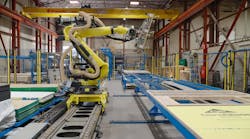The “Internet of Things” (IoT) is not some abstract, futuristic concept. Though still in its infancy, it is a reality for the HVAC industry, with the potential for capabilities and benefits that are truly awe-inspiring.
The IoT: What It Is and Why the HVAC and Commercial-Buildings Industries Need It
The IoT is the interconnection of components and systems with the Internet. It enables devices to send and receive data over a network, communicating without human-to-human or human-to-computer involvement. This enables more efficient and productive use of assets and processes. According to a report released by the Pew Research Center and Elon University’s Imagining the Internet Center, by 2025, the IoT will have “widespread and beneficial effects on the everyday lives of the public.”
Benefits of the IoT for the commercial-buildings industry are easy to identify—even now—and impact everyone from building owners and facility managers to specifying engineers and mechanical and service contractors. For example, HVAC systems that harness the IoT have the ability to predict future comfort and energy demands and proactively adjust to building and occupant needs. And with automated alarms and analysis, they can alert building owners via mobile devices when a problem will occur, offering them a chance to apply preventive maintenance or provide updates on changes in energy use.
How the IoT Works With HVAC Equipment
Building automation systems (BAS) produce a plethora of data. Until recently, these data have been underutilized. With the IoT, building owners can harness that information and put it to work at speeds not possible previously. This creates intelligent systems that share actionable data for system optimization without building owners having to go through significant integration efforts.
IoT technology works by seamlessly connecting equipment to the cloud and securely aggregating, filtering, and sharing data, unlocking efficiencies hidden in the data. Once significant operational data have been extracted from equipment and sent to the cloud, external data, such as weather forecasts and utility rates, are incorporated. This shifts, say, a rooftop unit from a reactive piece of equipment to a predictive one in the most energy-efficient way, resulting in significant savings and a greater degree of comfort for occupants.
Because data can be accessed on site or monitored remotely with real-time visibility via smartphone, laptop, or tablet, IoT-enabled intelligent systems take the guesswork out of asset management. Additionally, for systems configured with wireless capabilities, building information-technology networks can be bypassed, and data can be transported directly from equipment to the cloud and a service technician. This has the potential to change service models, as the real-time information allows technicians to speed up service delivery, arriving on site with the necessary parts in hand to tend to equipment before it loses efficiency.
Proactive Solutions and Unparalleled Service
With the IoT, issues that accompany reactive systems are avoided. IoT-enabled intelligent systems take into account outside factors (e.g., utility rates and weather forecasts) and aggregate data to modify system operation, ensuring systems operate at the most opportune times without a loss in system quality or occupant comfort. Additionally, with automated analysis, information is summarized, recommendations made, alarms communicated, equipment-maintenance issues recognized, and comfort-index calculations monitored. These actionable data lower operational costs, maximize energy efficiency and uptime, and increase occupant comfort.
Using IoT technology in HVAC applications may be the most efficient method of responding to and managing changes in climate. These intelligent HVAC systems act as “force multipliers,” allowing facility managers and service technicians to maximize uptime and system efficiency by identifying and responding to maintenance needs faster than ever before.
Optimal Operating Efficiencies and Benchmarking
With IoT technology, the power and performance of every unit in a system can be measured, which allows building owners to benchmark their buildings against buildings of similar size and use. With real-time data, building managers quickly and easily can monitor multiple units and multiple buildings to maintain peak operating efficiency, minimize energy consumption, and reduce total life-cycle costs. With this benchmarking capability, reporting the energy consumption of large commercial buildings to comply with environmental requirements and regulations is more feasible.
Replacing Traditional BAS With Intelligent HVAC Systems
Intelligent HVAC systems present an alternative to traditional BAS, as they combine the controls of a BAS with data integration and analytics. More enticingly, intelligent HVAC systems cost less than BAS and provide a simple, easy-to-install, and low-maintenance solution while incorporating the capability to be managed anywhere at any time to achieve maximum efficiencies.
Enhanced User Experience and Engagement
As intelligent systems become more complex, the user experience needs to become simpler. With such enormous amounts of data being gathered and converted into actionable analytics, intuitive user experiences that promote engagement are more important than ever. Intelligent HVAC systems do not place usability over performance; rather, both features are priorities. System providers that cannot deliver on this will fall behind.
Making Cybersecurity a Priority
As with anything involving the sharing of information between devices, solutions that identify and block sophisticated threats to the IoT are critical and will only become more so.
Internet-security companies will become increasingly involved with HVAC equipment to provide the most secure systems possible. Furthermore, built-in security features for both cellular and local-area-network connections will become common; implementation will have to be addressed at multiple levels within systems to ensure layers of security. This includes boot-level security, which allows only authorized users to update embedded software, at the hardware level.
Changing the Face of HVAC
Intelligent HVAC systems will create new opportunities for businesses. Companies that traditionally have been recognized as HVAC-equipment manufacturers will blur classification boundaries as they expand their footprints into the controls and software-as-a-service markets. These organizations will offer new services for rapid deployment of real-time remote diagnostics, monitoring, and control; advanced energy management; and third-party content integration.
With a number of new dynamics at play, specifying engineers must take all of a building’s IoT communication compatibilities—from HVAC and lighting to parking and building security—into consideration. Similarly, with more data, service technicians will be armed with real-time data 24/7, which will allow them to move from a reactive service model to a preventive one and quickly adjust inefficient systems. Facility and property managers will be able to monitor and adjust building and equipment assets remotely. And building managers and owners, with the ease of accessing automated analysis and reports, will become more accountable for their facilities’ and equipment’s energy use, which will help them to make better business decisions.
As IoT technology matures, there are likely to be impacts far beyond what we are able to predict today. For early adopters of intelligent HVAC systems, there are clear benefits that provide a competitive edge.
Paul Rauker is vice president of systems and controls for Daikin Applied. He is responsible for the company’s Intelligent Equipment product line, which harnesses the Internet of Things.
Did you find this article useful? Send comments and suggestions to Executive Editor Scott Arnold at [email protected].









